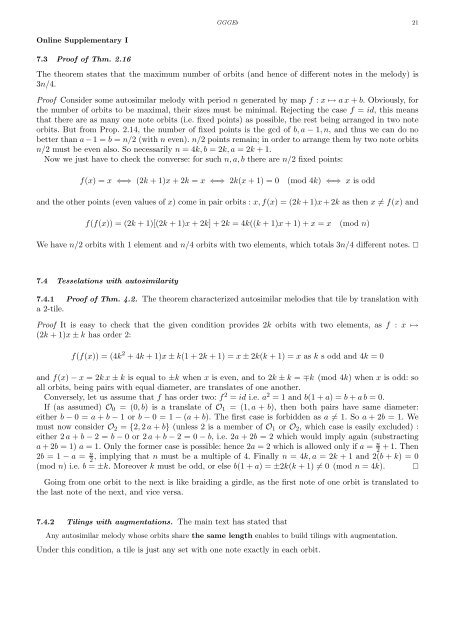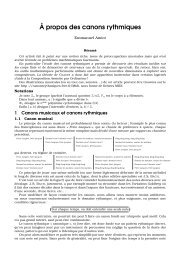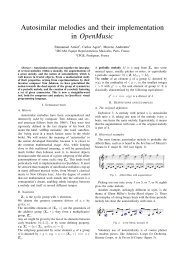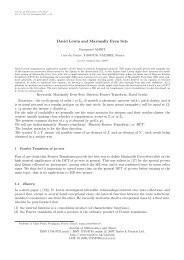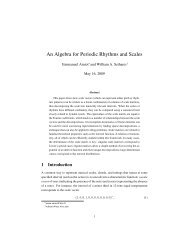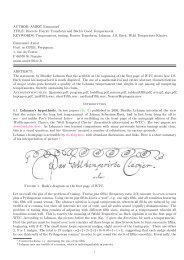Emmanuel Amiot Modèles algébriques et algorithmes pour la ...
Emmanuel Amiot Modèles algébriques et algorithmes pour la ...
Emmanuel Amiot Modèles algébriques et algorithmes pour la ...
You also want an ePaper? Increase the reach of your titles
YUMPU automatically turns print PDFs into web optimized ePapers that Google loves.
Online Supplementary I<br />
7.3 Proof of Thm. 2.16<br />
GGGE♭ 21<br />
The theorem states that the maximum number of orbits (and hence of different notes in the melody) is<br />
3n/4.<br />
Proof Consider some autosimi<strong>la</strong>r melody with period n generated by map f : x ↦→ a x + b. Obviously, for<br />
the number of orbits to be maximal, their sizes must be minimal. Rejecting the case f = id, this means<br />
that there are as many one note orbits (i.e. fixed points) as possible, the rest being arranged in two note<br />
orbits. But from Prop. 2.14, the number of fixed points is the gcd of b, a − 1, n, and thus we can do no<br />
b<strong>et</strong>ter than a − 1 = b = n/2 (with n even). n/2 points remain; in order to arrange them by two note orbits<br />
n/2 must be even also. So necessarily n = 4k, b = 2k, a = 2k + 1.<br />
Now we just have to check the converse: for such n, a, b there are n/2 fixed points:<br />
f(x) = x ⇐⇒ (2k + 1)x + 2k = x ⇐⇒ 2k(x + 1) = 0 (mod 4k) ⇐⇒ x is odd<br />
and the other points (even values of x) come in pair orbits : x, f(x) = (2k + 1)x + 2k as then x = f(x) and<br />
f(f(x)) = (2k + 1)[(2k + 1)x + 2k] + 2k = 4k((k + 1)x + 1) + x = x (mod n)<br />
We have n/2 orbits with 1 element and n/4 orbits with two elements, which totals 3n/4 different notes. <br />
7.4 Tesse<strong>la</strong>tions with autosimi<strong>la</strong>rity<br />
7.4.1 Proof of Thm. 4.2. The theorem characterized autosimi<strong>la</strong>r melodies that tile by trans<strong>la</strong>tion with<br />
a 2-tile.<br />
Proof It is easy to check that the given condition provides 2k orbits with two elements, as f : x ↦→<br />
(2k + 1)x ± k has order 2:<br />
f(f(x)) = (4k 2 + 4k + 1)x ± k(1 + 2k + 1) = x ± 2k(k + 1) = x as k s odd and 4k = 0<br />
and f(x) − x = 2k x ± k is equal to ±k when x is even, and to 2k ± k = ∓k (mod 4k) when x is odd: so<br />
all orbits, being pairs with equal diam<strong>et</strong>er, are trans<strong>la</strong>tes of one another.<br />
Conversely, l<strong>et</strong> us assume that f has order two: f 2 = id i.e. a2 = 1 and b(1 + a) = b + a b = 0.<br />
If (as assumed) O0 = (0, b) is a trans<strong>la</strong>te of O1 = (1, a + b), then both pairs have same diam<strong>et</strong>er:<br />
either b − 0 = a + b − 1 or b − 0 = 1 − (a + b). The first case is forbidden as a = 1. So a + 2b = 1. We<br />
must now consider O2 = {2, 2 a + b} (unless 2 is a member of O1 or O2, which case is easily excluded) :<br />
either 2 a + b − 2 = b − 0 or 2 a + b − 2 = 0 − b, i.e. 2a + 2b = 2 which would imply again (substracting<br />
a + 2b = 1) a = 1. Only the former case is possible: hence 2a = 2 which is allowed only if a = n<br />
2 + 1. Then<br />
2b = 1 − a = n<br />
2 , implying that n must be a multiple of 4. Finally n = 4k, a = 2k + 1 and 2(b + k) = 0<br />
(mod n) i.e. b = ±k. Moreover k must be odd, or else b(1 + a) = ±2k(k + 1) = 0 (mod n = 4k). <br />
Going from one orbit to the next is like braiding a girdle, as the first note of one orbit is trans<strong>la</strong>ted to<br />
the <strong>la</strong>st note of the next, and vice versa.<br />
7.4.2 Tilings with augmentations. The main text has stated that<br />
Any autosimi<strong>la</strong>r melody whose orbits share the same length enables to build tilings with augmentation.<br />
Under this condition, a tile is just any s<strong>et</strong> with one note exactly in each orbit.


